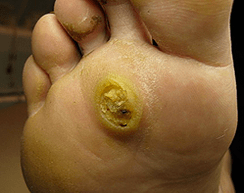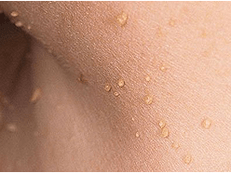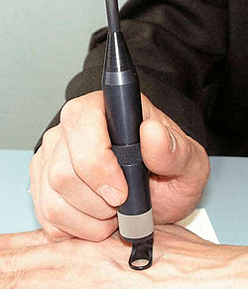Papilloma - benign tumor formation of the skin and mucous membranes of viral etiology.It is the appearance of a papilla on a narrow base (leg), a soft or dense consistency, from light to dark brown color.The localization of papilloma on the skin leads to the formation of a cosmetic defect in the larynx - impaired breathing, voice, on the mucous membrane of the internal organs - ulcerations and bleeding.The disease relapses are possible, the most impressive complication is a malignant degeneration.Papal removal can be carried out by electrocoagulation, cryodestruction, surgical excision, radio wave method or laser exposure.
General information
Papilloma - This is an illness that affects epithelial cells and skin.The cause of papillomas is the human papilloma virus, which belongs to the Papoviridae family, the Papillomavirus group.A distinction is made between HPV viruses with high and low oncogenic risk.The ability of the virus explain oncogenity papillomas to integrate its DNA into the genome of human cell.
The infection mechanism with the human papilloma virus
Once in the human body, in the early stages, HPV influences the basal cells of the epithelium.Microtrauma, wear, cracks and other skin damage contribute to the penetration of the papilloma virus into the body.For a long time, the virus can mainly multiply and do not manifest itself clinically (chronic car).When the virus spreads into the surface layers of the skin, cell hyperplasia is observed over time.
Since the human papilloma virus is nested in the external environment, the infection with direct contacts occurs.Forced sexual bonds lead to infections;Smoking, pregnancy, endometriosis, vitamin deficiency and immune deficios are predisposing factors, so that an infection occurs in interaction with the virus.The risk of infection, for example, increases with frequent contacts with bare human skin with massage.
Clinical manifestations of papillomas
Papilloma is a neoplasm of the skin or mucous membranes and looks like papillary growth that stands out above the surrounding tissue.Papillomas are located on the skin, mucous membranes, in the groin area and in the genitals, in some cases papillomas occur in the kidney pool and on the mucous membrane of the ureter.
Since papilloma consists of skin -covered connective tissue and contains blood vessels, bleeding is possible during trauma.The neoplasma grows up in different directions in the form of scattered papillae and looks like cauliflower.
The skin of the skin cannot change, but in most cases papillomas have color from white to dirty brown.Favorite localization - the skin of brushes and hands.Papillomatosis is widespread in patients with immunode celebrations.Primary changes in the skin begin 1-6 months after the infection.The concentration of the virus in the affected areas reaches the maximum from the 6th month from the moment of infection, it is this time that is most infectious.
Depending on the type of virus, the clinical manifestations of papilloma are variable.Vulgar papillomas therefore look in the form of a solid bump with a diameter of 1 mm with a rough keratiization area.Vulgar papillomas are susceptible to mergers and therefore often affect significant areas of the skin.Simple (vulgar) papillomas are localized everywhere, but more often they are affected by the skin of the fingers and the back of the palms.In children, especially young people, papillomas are affected, this is due to physiological characteristics, as children crawl without clothing.Typically, vulgar papillomas are in groups, but a longer existence of a single element has been possible for several years.Immune disorders and general diseases contribute to the spread of the process, in isolated cases vulgar papilloma is malignant.

The causes of the papillomas are papc 1.2.4.A few months after the infection on the skin of the sole, a small brilliant bump appears, which has all the signs of an ordinary papilloma and is surrounded by an protruding edge.In some cases, subsidiaries appear for small sizes around a papilloma that resembles bubbles to the outside.Then a mosaic papillomatosis is diagnosed.
Papillomas on the soles are often painful, especially when walking.In approximately 30% of cases, they are self -theft, and small children are more often observed.They are often confused with grains that occur between the fingers with longer compression.In contrast to papillomas, grains have a smooth surface and keep the skin pattern.
The causal means of flat papillomas are HPV 3.10.These papillomas of the unchanged skin color and appearance in the form of smooth flat tap, sometimes there can be a yellowish or slightly pink color more rounded outline.Multi -planned -Papillomas are also found.The neoplasia cause pain, itching, the affected area is hyperemic.

Film papillomas are diagnosed in half of those who have become older than 50 years over neoplasms on the skin and are also called Acrochords.They are located on the skin around the eyes, in the groin area, in the armpits and on the neck.First, a small yellowish color appears, which continues to increase and gradually converts into density, elastic elastic formations in size of up to 5 to 6 mm.If Acrochords are localized in places where trauma is possible, they are inflamed and injured.Film papillomas are not susceptible to a spontaneous disappearance.In patients with diagnosed thread papillomas, the rectal types are often observed.
HPV 13, 32 causes a local epithelial hyperplasia, which is characterized by the appearance of the mucous membranes of the mouth and on the red edge of the lips of small papillary neoplasms, which are slightly climbing over the skin and are susceptible to merger.
One of the papillomas that have been rarely found are the papillomas of Lewandovsky-Lutz (Warty epidermodisphelia).Most of the time children and young people are sick.Sometimes the Warty epider modisplasia is a family character.It looks clinically like several red -brown spotted papillomas on hands and feet.If there are papillomas in skin areas that are susceptible to ultraviolet radiation, they are malignant in 30% of cases and reborn in malicious tumors, with germination in neighboring tissue.
HPV, for example the pathogens made of peak condolences, can exist with a low, medium and high risk of physical degeneration.The PCR examination must always be carried out in the diagnosis of sharp conditions.The incubation period is several weeks to several months.Since the changes are minimal in some cases, these papillomas remain unnoticed.The main transmission path is sexual.The risk group includes people with immune deficiency and frequently changing sexual partners.On the outside they look like pink or light gray pigmented lace growth on the leg.
In most cases, pain, burning, itching, irritation when touched and friction with underwear is found, often injured and bleeding.They are located on the eve of the vagina, on small labia, less often, spicy condylomas in the vagina and on the cervix.The hole of the urethra is affected in men.In this way, the damage zone depends on sexual behavior.In people who practice anal contacts, pointed condylomas can be found in the perineum and in the perianal zone.In some cases, lace condylomas are diagnosed on the oral mucosa and on the red border of the lips, which in turn is associated with the properties of sexual activity.
Juvenile papillomas rarely grasp of larynx, they are caused by HPV 6.11;For the most part, children under the age of five are sick.In an infection occurs during birth, when the woman has papillomas in the vagina and the child during the birth canal, breathe premature breath.The disease is characterized by papillary growth in vocal bundles, which leads to the difficulty of the air circulation and language disorders.
Diagnosis of papillomas
The diagnosis of papilloma is carried out by a dermatologist or venereologist.Due to the large number of virus types, it has its own properties.It is possible to make a precise diagnosis that is only based in the classic case of the pointed warts based on a visual inspection.However, this does not provide precise information about the type of virus and its oncogenicity.In the event of suspected papillomatous nature of neoplasms, you can therefore use the PCR diagnostics of the DNA of the virus.
The PCR diagnostics not only enables the presence of the human papilloma virus in the body and to determine its type, but also to diagnose how many viruses are in the body at the time of analysis.This has a diagnostic value, since it knows the percentage of the virus content and its type, you can determine the approximate infection times and identify contact persons to examine and prescribe preventive therapy.PCR diagnostics also provides information about whether papillomas have a chronic course or a result of a simultaneous decrease in immunity.A reasonable therapy can be prescribed thanks to such data.
If the only treatment method is the removal of papillomas, a biopsy for cytological research is carried out in parallel to the operation.A histological examination of the tissue of papilloma provides more precise results, since the examination is subject to cells, so that the right place in its layers and the structural features of the tissue.This provides reliable results to the degrees of changes in the body and the likelihood of malignancy, since long -term and non -disqualical papillomas lead to cancer more often than the proven HPV with a high degree of oncoris.
As a rule, the PCR diagnosis in nature is a screening, and if the analysis confirms the presence of the virus, an additional study is carried out.
Papilloma treatment

The treatment scheme of papillomas is selected individually.If an HPV is demonstrated during the diagnosis, but there are still no clinical manifestations, preventive therapy is prescribed by cytostatics.It is very effective and enables you to "paint" the virus for several years.Patients who are carriers of HPV are recommended to carry out the PCR examination regularly and use barrier prevention in order not to endanger the human papillomavis infection with your partner.
Inozin Pranobex is a medication for the treatment of papillomas from the group of antiviral agents that suppress the reproduction of viruses.It is one of the most preferred because it has immune -modulating properties.Indications for use are diagnosed papillomas with a combination of other virus infections such as cytomegalovirus infections, measles and mumps.The presence of a herpes virus, chronic viral hepatitis and immune deficiency also requires the inclusion of isoprinosine in the treatment scheme.Since papillomewhere is long, the Papillo Pranobex may only be recorded under the supervision of a doctor, since it is required to control laboratory indicators.The use of immune modulators and vitamin courses is shown to all patients with HPV.
If there are manifestations of HPV on the skin and mucous membranes, depending on the localization and symptoms, you can use the cryodestruction of papillomas, electrocoagulation or the removal of papill laser.It is possible to use another modern method of surgical treatment -Papillomas with radio waves.When papilloma has signs of malignancy, the excision is carried out with a scalpel of the affected area with the recording of healthy tissue.
It should be taken into account that the removal of papilloma does not lead to a complete recovery, since today there are no medication on HPV in detail.Therefore, patients with previously diagnosed papillomas have to regularly examine and carry out antiviral therapy courses.
Since HPV is mainly sexually transmitted, the only prevention of papillomas is the barrier method of contraception.When planning pregnancy, it is necessary to diagnose the treatment of the virus and, if necessary, reduce the likelihood of infection of the child during birth and in the first years of life.




















